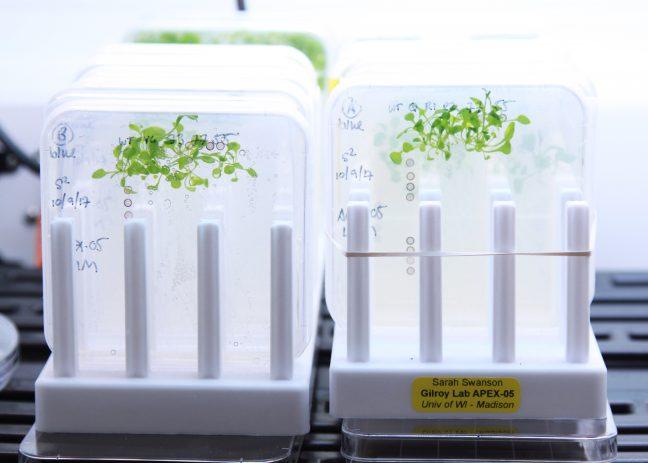As fossil fuels have continued to damage the Earth’s natural environments and increase in production costs, the University of Wisconsin and a team of other collaborators have come together to create new, reusable bioproducts that can act as suitable replacements to the fuels we currently use.
The Great Lakes Bioenergy Research Center was founded in 2007 by the U.S. Department of Energy and seeks to engineer bioenergy crops that can be grown on non-agricultural land. This benefits local ecosystems and cuts down on the need for agricultural land expansion. Research into these crops aims to find ways to utilize as much of each plant’s biomass as possible, reducing waste, increasing yields and minimizing damage to the environment.
UW graduate student Surajudeen Omolabake, who is conducting research at the GLBRC, discussed the importance of the project.
“Current fuel extraction processes such as those for petroleum have severe negative effects on the environment, so it is important to find alternative ways of accessing these fuels in a sustainable and eco-friendly way,” Omolabake said.
Over its 14 years of operation, the GLBRC has attempted to find such suitable alternatives and has made several advancements in the field of bioproducts.
One such discovery involves lignin, an organic compound that is key to forming the support tissue of many plants. Lignin makes up around 30% of many biomasses and is commonly discarded as waste, but according to the GLBRC, UW professor Shannon Stahl and his team were able to develop a way to efficiently break down lignin into its constituent components. These can then be used in the production of a wide variety of products such as plastic bottles, pharmaceuticals and jet fuel.
While advancements such as the one previously discussed solidified the GLBRC’s place as a significant part of the field of bioproducts, there are several current research projects that show great promise as well. One such study currently being conducted at the center aims to utilize bacteria to synthesize renewable fuels. Julia Martien is a PhD student at UW and leads research on the project.
The bacteria being studied is named Zymomonas mobilis. According to Martien, this bacteria has been used for many years as a fermentation agent in pulque, a Mexican alcoholic beverage. These fermentation processes are what generated an interest in researching the bacteria.
“We’re researching this fermentation process to better understand how this bacteria consumes and converts sugars so that we can tweak its metabolism and get it to produce things other than just ethanol,” Martien said.
One of the compounds Martien wants to engineer Zymomonas mobilis to produce is isobutanol, a desirable gasoline substitute due to its high energy density and low vapor pressure. Other potential compounds the bacteria could be engineered to produce include specialty chemicals that are used in products such as jet fuel, fragrances and food flavoring.
Once a satisfactory method of utilizing Zymomonas mobilis to produce new compounds is finalized, the products that are made using these compounds will be able to be produced in a much more stable and environmentally friendly manner than the harmful processes employed when extracting fossil fuels, Martien said.
Along with biological research, the GLBRC seeks to find the most effective method of implementing the project’s bioenergy crops and bioproducts. According to the GLBRC, models are created and analyzed to predict the sustainability, economic impact and life cycle of the bioproducts.
All of these areas of research work in conjunction with one another, and as such individuals coming from a wide range of professional backgrounds are involved with the GLBRC. Biologists, engineers, ecologists and economists work together to find the best ways to create and implement each bioproduct, Martien said.
The GLBRC’s collaborative efforts extend beyond just an individual level, as a multitude of institutions are all a part of the research center. UW and Michigan State University are the primary forces behind the project, but universities such as Princeton, Michigan Tech and Texas A&M contribute to the project’s research as well.
Several Bioenergy Research Centers are located at the institutions partnered with UW and work in conjunction with the GLBRC. The geographical diversity between each BRC means that research can be conducted in a wide range of environments.
This level of collaboration and diversity fosters an environment that promotes finding solutions as a team by communicating a wide range of ideas to one another. Annual GLBRC meetings are held and bring scientists from each institution involved in the project together so that they can showcase their research and findings.
“It’s been really nice to be able to get together to share research and collaborate on projects. It serves as great inspiration when thinking about where to take your research next,” Martien said. “Working through the GLBRC has allowed me to meet so many interesting and dedicated people in my field.”
The GLBRC also holds events catered towards those who aren’t members of the center. Lectures and seminars are held both online and at universities across the country to inform students and professors about bioproducts and their importance to the future of fuel and agricultural production. Festivals are also held for demographics both young and old, so those not familiar with bioproducts or the GLBRC can get involved.
As the conversation surrounding climate change and environmental conservation continues to grow in prevalence, the demand for green alternatives is only increasing. Fossil fuels account for 74% of greenhouse gas emissions according to the U.S. Energy Information Administration, but with projects like the Great Lakes Biology Research Center there is ever-increasing potential to end these harmful processes, keeping both our industries and our planet strong.


